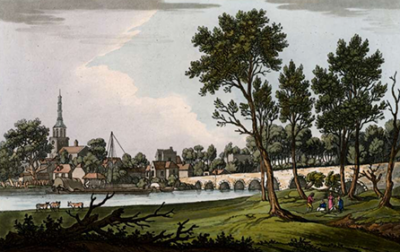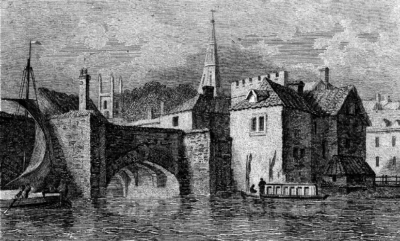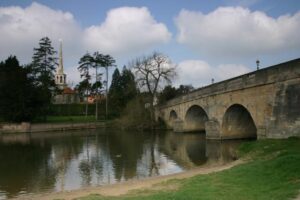
Wallingford Bridge was a fortified bridge on the east side of the town of Wallingford, Oxfordshire. Originally a timber design, 275 m (902 ft) long , the bridge was probably rebuilt in stone by Richard, Earl of Cornwall, in the 1230s as part of his development of Wallingford, before the town fell into decline in the following century. It saw fresh service as a fortification during the English Civil War of the 1640s, before being rebuilt between 1810 and 1813. It remains in use today, although a newer bridge further along the river carries most modern traffic.
History
11th-12th centuries

Wallingford was an important regional town in the medieval period, overlooking a key crossing point on the River Thames. It was a prosperous community, with its own mint for making coins, and the Anglo-Saxons protected it with a town wall. During the Norman invasion of 1066, Wigod of Wallingford, who controlled the town, supported William the Conqueror, and entertained the new King when his army arrived there. Immediately after the initial invasion, the King set about establishing control over the Thames Valley and constructed a royal castle in the town.
The middle part of the Thames at Wallingford was a busy waterway in the 11th century. There was probably a timber bridge at Wallingford by the time the Normans arrived, positioned alongside the older ford – a bridge was definitely in place by the mid-12th century, as it is mentioned in historical records.
Wallingford Bridge was 275 m (902 ft) long, a significant distance; for comparison, London Bridge was only just longer at 285 m (935 ft). Its length was due to the need to stretch over the river and the floodplain on the eastern side. By the 12th century, the bridge may have incorporated some stone to support the section of the bridge crossing the river.
The bridge was critical to the protection of the town. The bridgehead on the eastern side of the river formed part of the town’s defences, probably from the Anglo-Saxon period onwards, and was fought over during the 12th-century civil war of the Anarchy. Historians Neil Christie and Oliver Creighton describe the bridge as “a symbol of security to both town and castle”, while the medieval chroniclers of the Gesta Stephani recorded in 1152 that it was “the master-key, not only of the town but of the castle”.
13th -16th centuries
In 1231, Richard, the Earl of Cornwall, was given Wallingford Castle by King Henry III to use as his main residence. Richard lived in considerable style and spent substantial sums on the property. He also probably rebuilt Wallingford Bridge in stone as part of his redevelopment of the land around the castle. The historian Oliver Creighton describes how visitors arriving over the bridge would have seen “an elite watery setting containing mills, fishponds, a swannery and gardens” alongside the royal castle.
The new bridge probably had a formal gateway marking the entrance to the town on the near side of the river, similar to that at Oxford. There may have been a gatehouse protecting the far end of the bridge, possibly on the location of the later tollhouse. A leper colony lay just beyond the eastern side of the bridge. Somewhat later, in the 16th century, the bridge was recorded as having twenty arches, which probably reflects its original medieval design.
The maintenance of the bridge was supported by a special tax called pontage, approved by the Crown, and collected from 1344 onwards. During the 14th century, a small team looked after collecting this, variously called stewards, wardens and bridgemen. After the first award of pontage, further grants were made in 1383, 1407, 1429 and 1433. The local Priory of the Holy Trinity was demolished between 1528 and 1529, and some of its stone was reused on the bridge.
Nonetheless, various accidents were reported on the bridge during the 15th and 16th centuries, allegedly because of its poor condition, and in the 1570s there were investigations into the misuse of the toll revenue.Wallingford was already in economic decline by the end of the 14th century. This was soon exacerbated by the construction of a new bridge at Abingdon – the Great Bridge, or Burford Bridge – which took trade away from Wallingford Bridge.
17th-21st centuries

By the 17th century, the mid-section of the Thames was declining in importance of a trade route, and with it the importance of Wallingford. But when the English Civil War broke out between the supporters of Charles I and Parliament in the 1640s, the Thames Valley once again became a critical war zone.
Wallingford was a Royalist town, with a garrison established there in 1642 to prevent an advance on Oxford to the north-west. Colonel Thomas Blagge was appointed governor. He cleared the nearby houses on the west side, and the chapel of Mary Grace on the east side of the river, to provide a field of fire, and removed four of the bridge arches, replacing them with two drawbridges and wooden operating towers.
By 1644, the surrounding nearby towns of Abingdon and Reading had fallen and in 1645 Parliamentary forces unsuccessfully attacked the town of Wallingford. General Thomas Fairfax placed Wallingford Castle under siege the following year; after 16 weeks, the castle finally surrendered in July 1646 under generous terms for the defenders.

The new drawbridges remained in use until 1751, when Joseph Absolon, a local architect, was paid to replace them in brick and stone. In 1800, the bridge probably comprised nineteen arches, still largely following the 13th-century design.
In 1809, however, there was bad flooding along the Thames, seriously damaging the bridge. An Act of Parliament was passed, ordering the reconstruction of much of the bridge, including widening it on the northern edge to allow for better movement of traffic. The work was carried out between 1810 and 1813, giving the bridge its current Georgian appearance, with seventeen arches spanning the river and the floodplain. As part of the work, a tollhouse was built on the eastern side.
In 1934, the tollhouse was pulled down. Wallingford Bridge today remains in daily use, although most traffic uses the newer Winterbrook Bridge, opened in 1993. Wallingford Bridge is protected under UK law as a Scheduled Monument.
Bibliography
- Christie, Neil and Oliver Creighton, with Edgeworth, Matt and Helena Hamerow. (2013) Transforming Townscapes, From Burh to Borough: The Archaeology of Wallingford, AD 800-1400. London, UK: The Society for Medieval Archaeology.
Attribution
Photographs on this page are drawn from the British Museum and Geograph, as of 7 July 2023, and attributed and licensed as follows: “Wallingford Bridge 1793“, image copyright The Trustees of the British Museum, released under CC BY-NC-SA 4.0; “Wallingford Bridge in the flood“, author Des Blenkinsop, released under CC BY-SA 2.0; “Wallingford Bridge 1796”, image copyright The Trustees of the British Museum, released under CC BY-NC-SA 4.0; “Wallingford Bridge today”, author Alexander P. Kapp, released under CC BY-SA 2.0.
